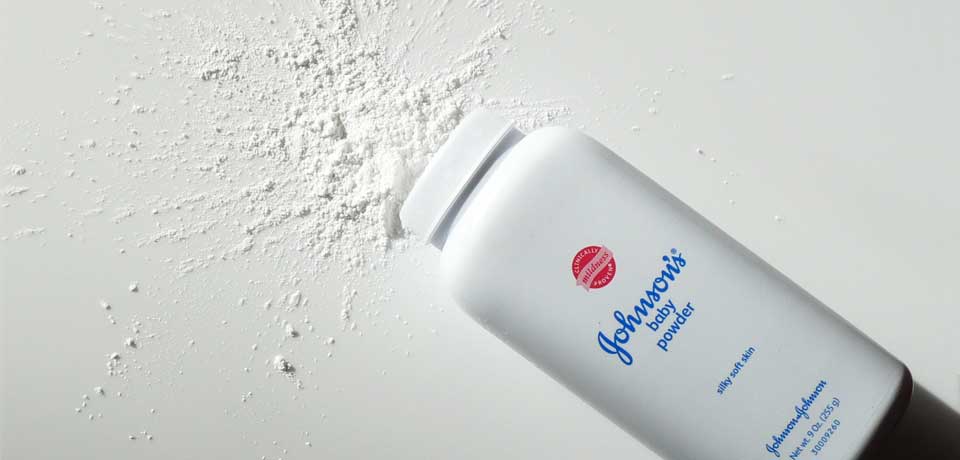Talcum powder and ovarian cancer
In a recent lawsuit pharmaceutical giant Johnson & Johnson has been ordered to pay US$72 million in damages to the family of a woman who was a prolific talcum powder user and died from ovarian cancer.
However, there is concern among medical experts that the verdict is not based on all the scientific facts.
Professor Paul Pharoah, Professor of Cancer Epidemiology at the University of Cambridge believes the court’s decision is flawed for two reasons:
“First, the evidence of a causal association between genital talc use and ovarian cancer risk is weak. Second, even if the association were true, the strength of the association is too small to be able to say on the balance of probabilities that any cancer arising in a woman who used talc had been caused by the talc,” he said.
Prof Pharoah also pointed out that there are a number of different types of ovarian cancer, including serous, clear cell, mucinous and endometrioid which all have distinct characteristics and different causative risk factors.
Despite Prof Pharaoh’s statement that the decision of the court is flawed, he does concede that:
“The association is biologically plausible. Talcum powder applied to the genital area might get into the fallopian tubes and onto the ovaries and cause inflammation, which in turn could cause ovarian cancer.”
A pooled analysis published recently (1) included 8,525 cases and 9,859 controls and found that there was a significant association between genital powder use and epithelial ovarian cancer (odds ratio 1.24, 95% confidence interval 1.15–1.33).
Similar results were found for other types of ovarian cancer including invasive serous (1.20, 1.09–1.32), endometrioid (1.22, 1.04–1.43), and clear cell (1.24, 1.01–1.52) and borderline serous ovarian cancer (1.46, 1.24–1.72). These odds ratios equate to approximately a 20% increase in the risk of ovarian cancer for genital powder users.
Lead author of the study, Dr Kathryn Terry of Harvard Medical School, Boston, MA, USA, published the work in the journal Cancer Prevention Research and concluded:
“Our large pooled analysis of case-control studies shows a small-to-moderate (20–30%) increased risk of ovarian cancer with genital-powder use, most clearly pertaining to non-mucinous epithelial ovarian tumours.”
“Since there are few modifiable risk factors for ovarian cancer, avoidance of genital powders may be a possible strategy to reduce ovarian cancer incidence,” she added.
It is worth noting that an association has also been reported between endometrial cancer and perineal talcum powder use in a large study. (2)
What led researchers to suspect that talcum powder may be a risk factor for ovarian cancer in the first place?
Talc and asbestos are both hydrous magnesium silicate compounds. As early as 1982 an association was found between talcum powder use and ovarian cancer (3). At that time, the authors stated that their primary reason for investigating the association was because ovarian cancer has very similar the pathological characteristics to mesothelioma, a cancer strongly associated with asbestos exposure. Prior to 1976 talcum powder was often contaminated with asbestos fibres and this relationship led to concern over its potential carcinogenicity. A number of studies also identified that talc particles were found in ovarian tumour tissue. (4)
What else can alter the risk of ovarian cancer?
Genetic variation in the BRCA1 gene is one of the highest risk factors for ovarian cancer conferring a lifetime risk of 400 in 1000. Using the oral contraceptive pill in the early reproductive years has been associated with a reduced risk. Breast feeding and tubal ligation have also been associated with reduced risk.
A note of caution
Several research articles reporting lack of association between talcum powder and ovarian cancer have been directly, or possibly indirectly, funded by Johnson & Johnson or others with an interest in proving that talc is harmless.
For example:
This manuscript: Huncharek M, Muscat J, Onitilo A, Kupelnick B. Use of cosmetic talc on contraceptive diaphragms and risk of ovarian cancer: a meta-analysis of nine observational studies. Eur J Cancer Prev. 2007 Oct;16(5):422-9. PubMed PMID: 17923813.
States: “Funding for this work was provided by a grant from Luzenac American Inc., and Johnson and Johnson Consumer and Personal Products Worldwide.”
Luzenac.com is the owner of Imerys Talc is the world’s leading talc producer.
This manuscript: Muscat JE, Huncharek MS. Perineal talc use and ovarian cancer: a critical review. Eur J Cancer Prev. 2008 Apr;17(2):139-46. doi: 10.1097/CEJ.0b013e32811080ef. Review. PubMed PMID: 18287871.
States: “Supported by a contract from Crowell Moring, Inc. and Public Health Service Grant K07-CA104231.”
Crowell Moring, Inc. is an international law firm that acts for the above companies.
Interestingly, The Cancer Council of WA published an information sheet in 2013 about the myth of talc causing ovarian cancer. One of the key studies they cite is Huncarek et al. 2007 – a study funded by Johnson & Johnson.
Back in 2004, Mills et al. (5) published a study in the International Journal of Cancer that found a small but significant relationship between ever use and non-use of talc and the risk of epithelial ovarian cancer (around a 37% increase in risk). At this time the researchers concluded:
“…users should exercise prudence in reducing or eliminating use. In this instance, the precautionary principle should be invoked, especially given that this is a serious form of cancer, usually associated with a poor prognosis, with no current effective screening tool, steady incidence rates during the last quarter century and no prospect for successful therapy. Unlike other forms of environmental exposures, talcum powder use is easily avoidable.”
References
1. Terry et al. 2013 Cancer Prev Res (Phila). 2013 Aug; 6(8): 811–821.
2. Karageorgi et al. Perineal use of talcum powder and endometrial cancer risk. Cancer Epidemiol Biomarkers Prev. 2010 May;19(5):1269-75.
3. Cramer et al. Obstetrical and Gynecological Survey 37(11) · November 1982
4. Heller et al. American Journal of Obstetrics and Gynecology , Volume 174 (5) – May 1, 1996
5. Mills et al. Int. J. Cancer: 112, 458–464 (2004)
Dr Ruth Hadfield is a freelance medical writer based in Sydney, Australia. You can read more about her on her website here or contact her here.
DISCLAIMER: THIS WEBSITE DOES NOT PROVIDE MEDICAL ADVICE
Always seek the advice of your physician or other qualified health care provider with any questions you may have regarding a medical condition or treatment and before undertaking a new health care regimen, and never disregard professional medical advice or delay in seeking it because of something you have read on this website. The information, including but not limited to, text, graphics, images and other material contained on this website are for informational purposes only. The purpose of this website is to promote broad consumer understanding and knowledge of various health topics. It is not intended to be a substitute for professional medical advice, diagnosis or treatment. We do not recommend or endorse any specific tests, physicians, products, procedures, opinions or other information that may be mentioned on this website. Reliance on any information appearing on this website is solely at your own risk.

